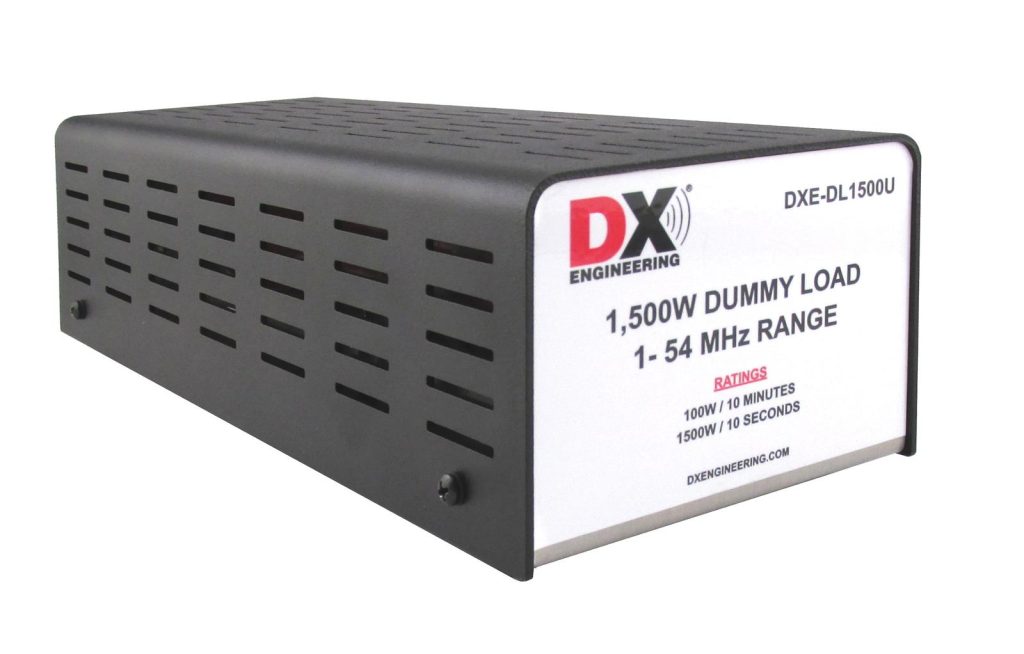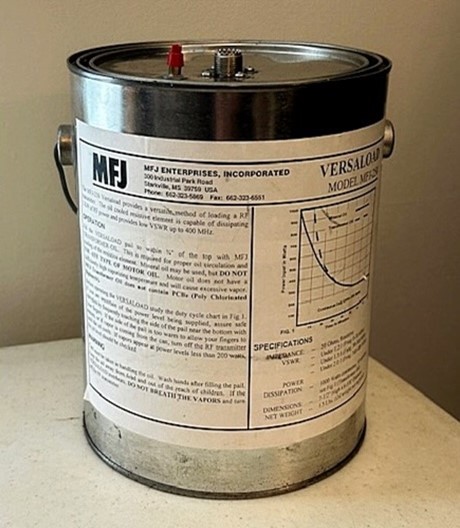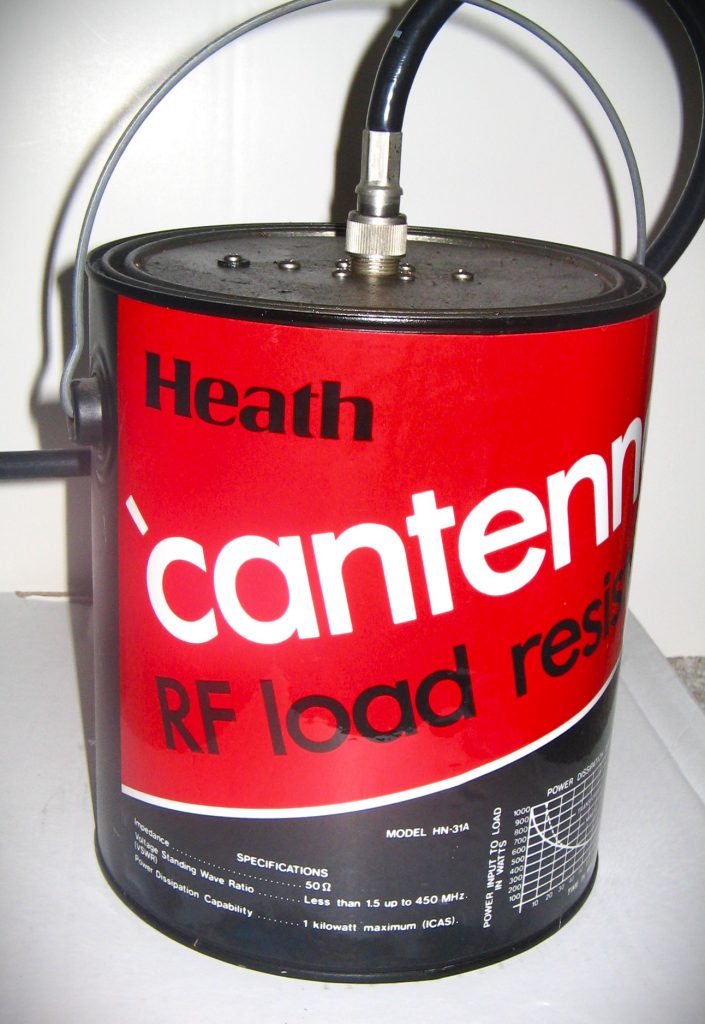Several options available at DX Engineering, including the new DXE 1,500W 1-54 MHz Dry Dummy Load
You may have heard the term “dummy load” before. While the name might give you an idea of what it does, dummy loads are a misnomer—they are real loads that absorb RF energy and dissipate it as heat.
An RF dummy load is an important piece of test equipment used in radio frequency (RF) systems, particularly in amateur radio, broadcast engineering, and telecommunications. It may appear to be just a fancy resistor, but in reality a dummy load plays an essential role in safely testing and tuning radio transmitters without radiating radio signals. To understand why a dummy load is necessary, let’s explore how it works and the benefits it provides during transmitter testing, tuning, and maintenance.
How Does a Dummy Load Work?
A dummy load is a non-inductive resistor that is used in place of an antenna when testing or tuning a radio transmitter. It simulates the electrical characteristics of a perfect antenna—specifically a 50-ohm impedance—but doesn’t radiate any significant amount of radio frequency energy.
Instead of converting electrical energy into electromagnetic waves as an antenna does, the dummy load converts it into thermal energy—heat. The heat is safely dissipated through materials such as resistors, oil, and heat sinks.
To work effectively, the dummy load must:
- Match the impedance of the transmission line and transmitter
- Handle the transmitter’s power output without overheating
- Maintain a low SWR to minimize reflected power
Why You Need One
RF transmitters are designed to operate with a specific load impedance, typically 50 ohms. Not using an antenna or a dummy load can result in damage to the equipment. The resulting reflected power can cause rapid heat buildup and damage to the transmitter’s output circuitry.
When working on a transmitter, you may need to perform tasks such as measuring output power, testing modulation, and monitoring RF signals. A dummy load creates a controlled environment for these kinds of diagnostics. By using a dummy load, you protect your radio from the risks associated with high SWR, including overheating, power reduction, or even circuit failure. You also avoid creating QRM on the air that interferes with other radio transmissions.
They can also be used for routine tasks, like checking coax cables. Attach a dummy load to one end of the coax and the other end to an antenna analyzer or digital voltmeter set to measure resistance. Need to diagnose a tuner that isn’t working? Putting a 50-ohm load on the tuner antenna output may help you find the problem. Dummy loads are also used in laboratory and testing environments to calibrate instruments like oscilloscopes and spectrum analyzers.
How Do You Choose a Dummy Load?
Dummy loads come in a variety of shapes, sizes, and power ratings. Regardless of features, all dummy loads serve the same function: to provide a safe and non-radiating load for a radio transmitter.
Low-power dummy loads are used for handhelds or HF/VHF/UHF radios in the 10- to 100-watt range. They’re ideal for quick testing and easy to carry. High-power dummy loads can handle hundreds or thousands of watts and are typically used in conjunction with base stations or linear amplifiers. They often include oil cooling, fans, or heat sink arrays to manage thermal loads.
When damaged, the dummy load reflects power back to the transmitter. A good rule of thumb is to pick a dummy load rated at least twice the transmitter’s/amplifier’s output.
Other important specs include:
- Impedance: Typically 50 ohms
- Frequency Range: The usable range without excessive reactance (e.g., DC–3 GHz)
- VSWR: Should be as close to 1:1 as possible
- Duty Cycle: Some dummy loads can handle short bursts at high power, but not prolonged use. For example, the DX Engineering DXE-DL1500U 1,500W Dry Dummy Load handles 1,500 watts for 10 seconds (key-down CW) and 100 watts for 10 minutes.

Dummy loads may have additional features such as built-in watt meters, cooling fans, or oil immersion for high-power dissipation. Air-cooled (dry) versions need sufficient space to allow air to circulate around them to prevent overheating. Look for adequate air vents in the case or a large heatsink—they’re a crucial part of a dummy load’s thermal management system.
You’ll see that air-cooled varieties are readily available, often using high-power resistors specifically designed for RF applications. There are also the classic oil-filled Heathkit HN-31 and other Cantenna variants from Dentron and MFJ that can be found used.


You can also build one of your own. A quick internet search for a Cantenna dummy load will yield a lot of information on its construction.
Here’s a sampling of currently available dummy loads at DX Engineering. Match your power and frequency needs.
| Model | Cooling | Freq. Range | Max. Resistor | Rating |
|---|---|---|---|---|
| DXE DL-1500U | air | 0 – 54 MHz | 50 Ohm | 1,500W |
| Palstar DL-1500 | air | 0 – 500 MHz | 50 Ohm | 1,500W |
| Elecraft DL1 (kit) | air | 0 – 225 MHz | 50 Ohm | 100W |
| Diamond DL30A, DL30N | air | 0 – 500 MHz | 50 Ohm | 100W |
| Coaxial Dynamics 4151 | air | 0 – 2.5 GHz | 50 Ohm | 150W |
Don’t Be a Dummy
A dummy load is not only a convenience—it’s an important tool for safe radio diagnosis and operation. Whether you’re a beginner learning the ropes or an advanced operator testing a new amplifier, a dummy load ensures that your radio testing doesn’t interfere with others on the air, damage your equipment, or violate FCC regulations.
By absorbing RF energy instead of transmitting it, dummy loads allow you to tune, troubleshoot, and experiment with confidence. Every ham radio operator should have at least one in their toolbox or shack.

